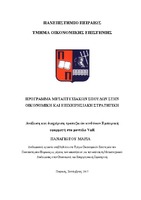Ανάλυση και διαχείριση τραπεζικών κινδύνων: εμπειρική εφαρμογή στο μοντέλο VaR
Bank risk management methods: experimental study with the VaR model

Προβολή/
Λέξεις κλειδιά
Διαχείριση κινδύνου ; Χρηματοπιστωτικά ιδρύματα ; Πιστωτικός κίνδυνος ; Κίνδυνος αγοράς ; Οικονομετρική ανάλυση ; Τραπεζικοί κίνδυνοι ; Risk management ; Financial institutions ; Credit risk ; Market risk ; Econometrics ; Value at RiskΠερίληψη
Στην παρούσα διπλωματική εργασία αναλύονται οι κίνδυνοι με τους οποίους έρχονται αντιμέτωπα τα τραπεζικά ιδρύματα της χώρας. Στη συνέχεια αναλύεται η διαχείριση των κινδύνων μέσα από τις μεθοδολογίες για το κάθε είδος κινδύνου ξεχωριστά. Οι κίνδυνοι καθορίζουν την ορθή λειτουργία του χρηματοπιστωτικού συστήματος και γι' αυτό γίνεται αναφορά στους ρυθμιστικούς κανόνες που θεσπίστηκαν για την ομαλότερη λειτουργία αυτού.
Στην συνέχεια επιλέχτηκε να γίνει μια εμπειρική εφαρμογή στην μεθοδολογία Value at Risk - VaR, που αναφέρεται κυρίως στον κίνδυνο αγοράς και σε ορισμένες περιπτώσεις στον πιστωτικό κίνδυνο. Η εμπειρική εφαρμογή έγινε στο οικονομετρικό πρόγραμμα Eviews. Τα δεδομένα που χρησιμοποιήθηκαν είναι οι ημερήσιες τιμές των μετοχών των τεσσάρων συστημικών τραπεζών για διάστημα δυο χρόνων από 1/9/2015 έως 1/9/2017. Αρχικά γίνεται υπολογισμός των ημερησίων αποδόσεων των μετοχών και τα περιγραφικά στατιστικά μέτρα αυτών. Κατόπιν γίνεται έλεγχος της στασιμότητας της χρονοσειράς των αποδόσεων. Οι χρονοσειρές των τιμών των τεσσάρων τραπεζών χαρακτηρίστηκαν ως μη στάσιμες κάτι το οποίο δεν ισχύει και για τις αποδόσεις .Έτσι γίνεται έλεγχος αυτοσυσχέτισης καταλοίπων για να γίνει η εκτίμηση της διακυμάνσεις με το μοντέλο GARCH με σταθερό όρο. Η χρονοσειρά της διακύμανσης που προέκυψε χρησιμοποιήθηκε στην εκτίμηση του Value at Risk.
Στη συνέχεια επιλέχθηκε ένα χαρτοφυλάκιο από τρεις μετοχές (Eurobank, ΟΤΕ, Terna) που ανήκουν σε διαφορετικούς κλάδους (για να υπάρχει διαφοροποίηση) με διαφορετικά πρόσημα στους ρυθμούς ανάπτυξης, αφού ο τραπεζικός παρουσιάζει πτώση, ο κλάδος των τηλεπικοινωνιών αύξηση και των κατασκευών στασιμότητα και εφαρμόστηκε η μέθοδος της ιστορικής προσομοίωσης για να υπολογιστεί η Var χαρτοφυλακίου. Στους συγκεκριμένους υπολογισμούς χρησιμοποιήθηκε το Excel. Εν κατακλείδι τα συμπεράσματα που προέκυψαν από την εμπειρική εφαρμογή είναι τα αναμενόμενα με βάση την χρονική περίοδο την οποία διανύουμε. Ένας επενδυτής ο οποίος επενδύει σε τραπεζικές μετοχές έχει περισσότερες πιθανότητες να υποστεί ζημία παρά κέρδη. Στην περίπτωση του χαρτοφυλακίου όπου εφαρμόστηκε η μέθοδος της ιστορικής προσομοίωσης παρατηρείται ότι υπάρχουν μέρες που το χαρτοφυλάκιο παρουσιάζει κέρδη και μέρες που παρουσιάζει ζημίες κάτι το οποίο είναι σύνηθες εφόσον το χαρτοφυλάκιο περιλαμβάνει διαφορετικές μετοχές.


